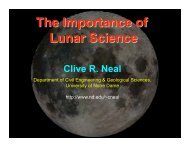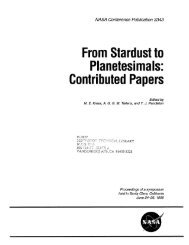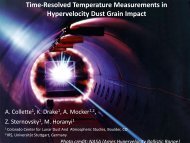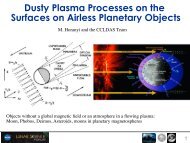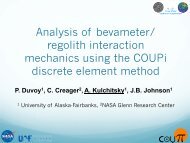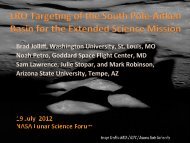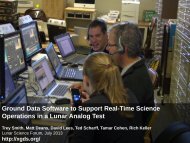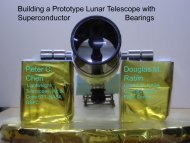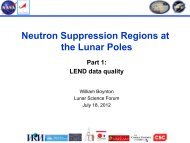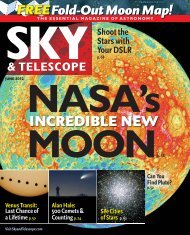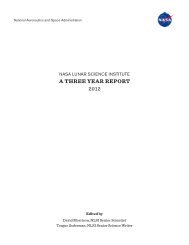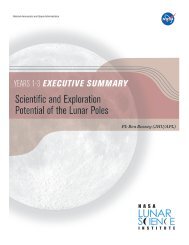Jean-âPierre Williams (UCLA) - NASA Lunar Science Institute
Jean-âPierre Williams (UCLA) - NASA Lunar Science Institute
Jean-âPierre Williams (UCLA) - NASA Lunar Science Institute
Create successful ePaper yourself
Turn your PDF publications into a flip-book with our unique Google optimized e-Paper software.
<strong>Jean</strong>-‐Pierre <strong>Williams</strong> (<strong>UCLA</strong>) <br />
David Paige (<strong>UCLA</strong>) <br />
Paul Hayne (Caltech) <br />
Matthew Siegler (Caltech/JPL)
¡ Surface Roughness and Rocks influence observed <br />
brightness temperatures (T b ) <br />
¡ Anisothermality <br />
§ Derived T b in each Diviner channel differs <br />
¡ Spectral emissivity <br />
§ Spectral contrast due to emissivity superposed <br />
¡ Thermal diffusion modeling (3D) <br />
§ Comsol Multiphysics finite element package
¡ <strong>Science</strong> goals: <br />
§ Characterize the lunar thermal <br />
environment. <br />
§ Map surface properties such as thermal <br />
inertia, rock abundance and silicate <br />
mineralogy. <br />
§ Determine the locations and temperatures <br />
of volatile cold traps in the polar regions.
Topography – slopes and shadows <br />
Vertical variation in regolith <br />
(Low density upper layer) <br />
Diviner surface <br />
footprint <br />
̴500× 250 m <br />
Lateral heterogeneities <br />
in thermophysical properties <br />
(e.g. embedded rocks)
¡ Uniform surface temperature: derived T b in <br />
each infrared spectral channel the same <br />
¡ Multiple temperatures in FOV: derived T b in <br />
each channel differs. <br />
§ Non-‐linear nature of Plank radiance with respect to <br />
wavelength <br />
§ Warmer temperatures have an increased <br />
proportional influence on T b at shorter wavelengths <br />
§ Can estimate rock abundance (Bandfield et al., 2011)
Equatorial observations in Oceanus Procellarum (±0.2° Lat) <br />
Daytime <br />
Nighttime <br />
High incidence angles
<strong>NASA</strong>/GSFC/Arizona State University <br />
<strong>NASA</strong> / Philip Stooke, University of Western Ontario
Equatorial surface temperatures and albedo used to derive bulk density and <br />
thermal conductivity with depth of ∼1 m (Vasavada et al., 2012) <br />
§ temperatures best fit using graded regolith model <br />
▪ ∼ 40% increase in bulk density <br />
▪ Eightfold increase in thermal conductivity in upper ∼ 20 cm <br />
Highlands: rougher, more sca3er <br />
Maria: smoother, but with warm <br />
rocks <br />
Remarkably similar on average <br />
New Thermophysical Model of the Near-‐Surface <strong>Lunar</strong> Regolith [Vasavada et al., 2012]
Number 2 footpad of Surveyor 3 [<strong>NASA</strong>/Apollo 12] <br />
Surface T ~ 95‒390 K
Local time: 19:30 <br />
10 cm <br />
5 cm
¡ Surface temperatures exhibit extreme spatial <br />
variations at all length-‐scales <br />
¡ Details of the regolith's thermal response to <br />
solar forcing provide information about the <br />
radiative and thermophysical properties, <br />
structure, and rock abundance of the near-surface<br />
layer <br />
¡ Explore different length scales of topography <br />
and heterogeneities in the regolith <br />
e.g. Diviner sensitivity to surface roughness and <br />
rock size



